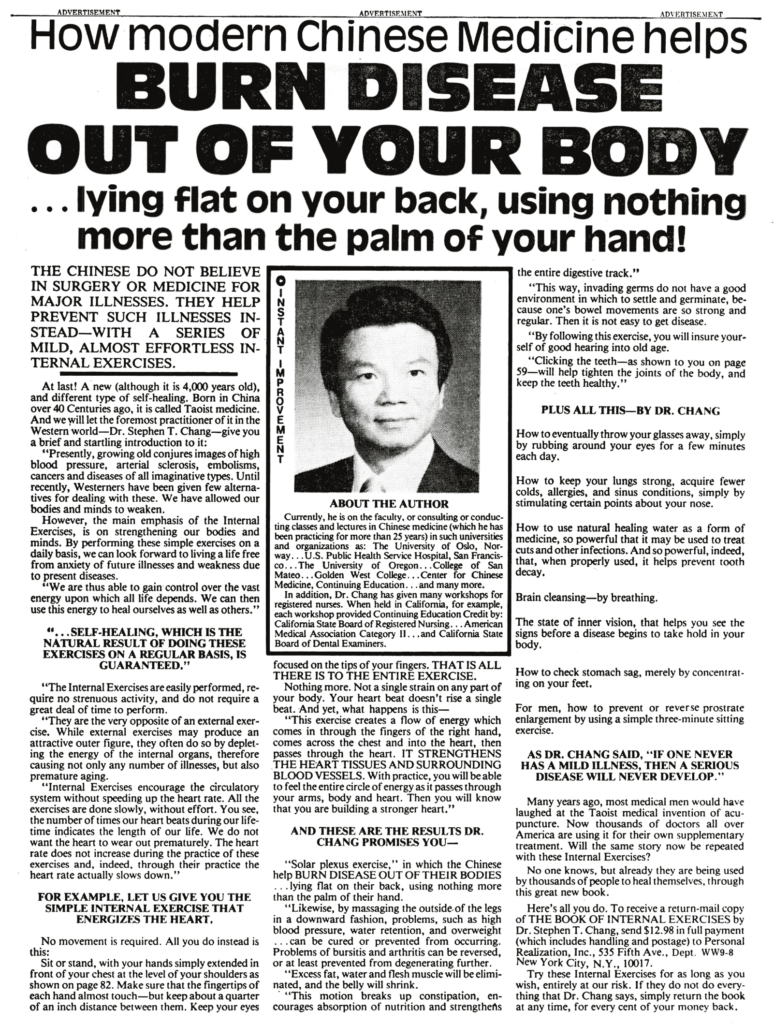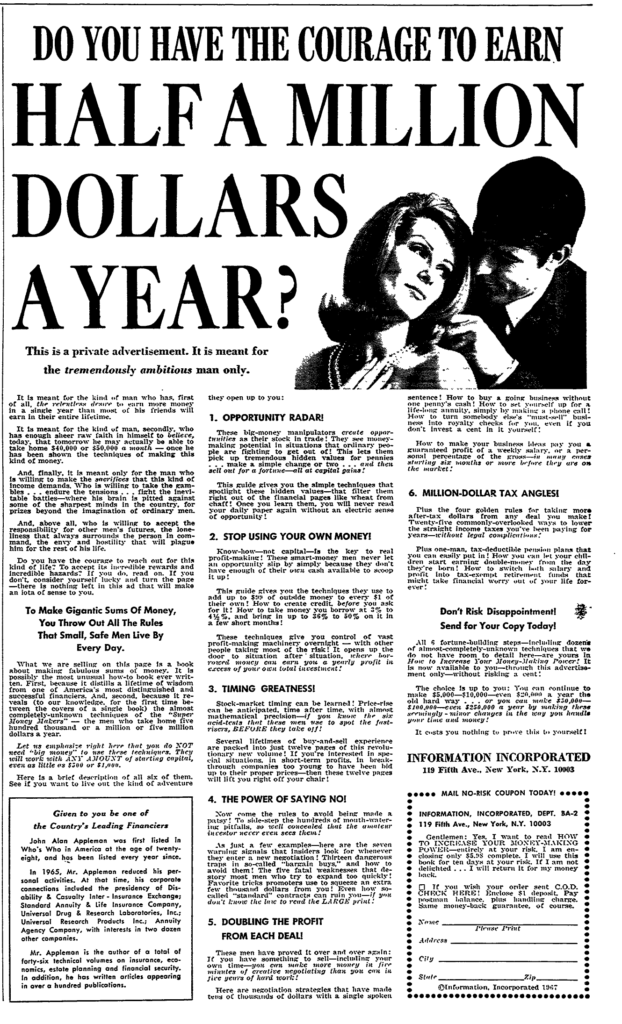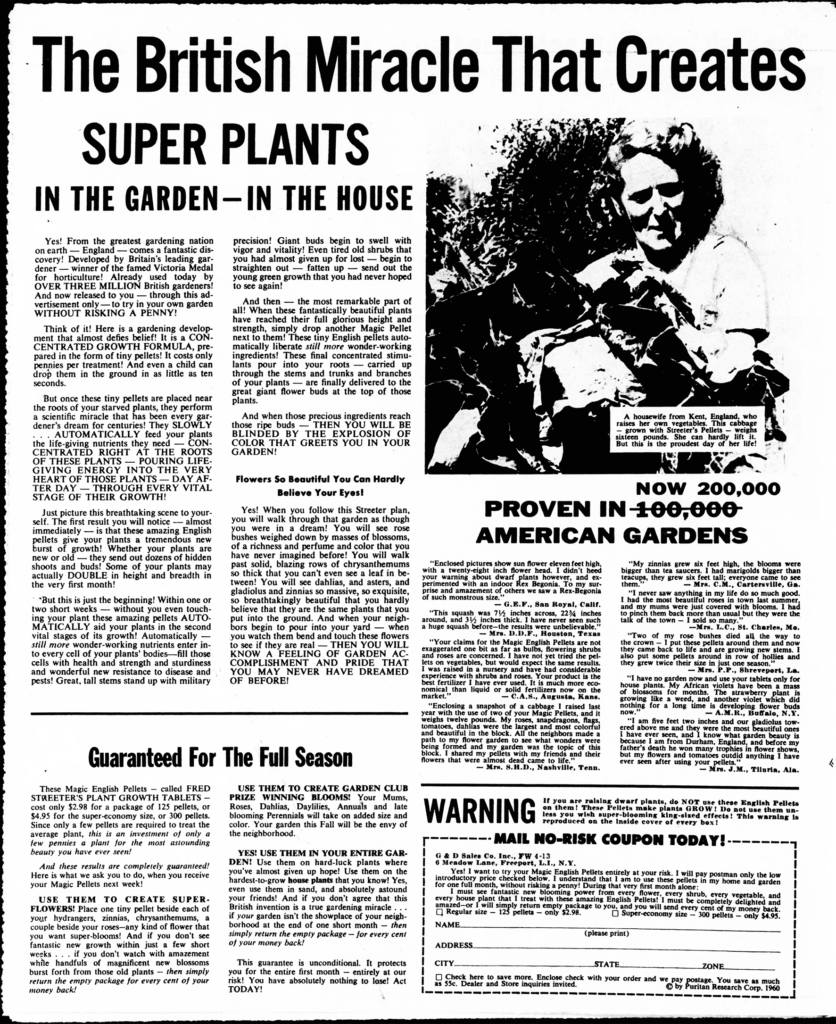Eugene Schwartz was an advertising copywriter whose speciality was direct-mail campaigns and the author of 10 books, including “The Brilliance Breakthrough” and “Breakthrough Advertising”, which is widely regarded as the holy grail of copywriting books.
An absolute genius at writing successful copywriting campaigns, he has a “Hit Ratio” (the percentage of winning ads) of 85%, one of the highest in all copywriting history. That’s like a baseball player having a batting average of 850.
He has also written some of the most celebrated headlines in direct-mail advertising, such as “Give Me 15 Minutes And I’ll Give You a Super-Power Memory” and “Read 300 Business Magazines in 30 Minutes.”
This time I copyworked and analysed 5 of Eugene Schwartz’s ads, including his famous Boardroom Reports letter.
As always, Schwartz’s swipe file is at the bottom of the page.
- Lesson 1: Creating An Image In Your Reader’s Mind
- Lesson 2: Focus On Desire
- Lesson 3: Headlines
- Lesson 4: Closing
- Summarizing Eugene Schwartz’s Structure and Style
- Eugene Schwartz’s Mindset And Copywriting System
- Eugene Schwartz’s “Boardroom Reports” Letter
- Eugene Schwartz Swipe File
- Lessons From Other Great Writers
Lesson 1: Creating An Image In Your Reader’s Mind
Like Halbert, Schwartz writes to create an image in the reader’s mind. To achieve this he writes short sentences that readers can easily understand…and links those sentences up with connector words.
The goal is to make the copy easily readable and convince people to act.
Before discussing the product, he often emphasizes that this product (and ad) is not for everyone and that it can be tough, but makes the reader imagine a desirable outcome or trait that he/she aspires to.
Schwartz forces readers to self-select: “if you do, action A” and “if you don’t, action B”.
Do I belong to group A or group B?
With Schwartz everything works “like magic”, it occurs “within weeks” or “almost immediately” and with “no effort”.
Downplaying time and effort and exaggerating the effects, he forces readers to imagine the outcome with future-pacing (like Bencivenga), “what if” scenarios and describing what “actually” happens when you use the product.
Even Schwartz’s use of testimonials makes the reader imagine himself in the reviewers’ shoes as he uses three types:
- Before-after. Focus on the after. Use the ones that exaggerate the results and make them vivid for readers.
- What the neighbours think/feel/say. This adds social validation.
- Enhance perceived authority. “I know what garden beauty is because I am from Durham, England, and before my father’s death he won many trophies in flower shows.”
Lesson 2: Focus On Desire
Schwartz’s calling card. From the headline to the final sentence, Schwartz never forgets his focus: what the reader desires. Not what they want. Not the benefits. Not the results the product offers them. But the desire underlying everything.
Why does the reader want to achieve this outcome?
Social validation?
A sense of belonging?
Pride?
Longing for something?
A good example is his Swedish Miracle ad (see Swipe File at the bottom). In the ad Schwartz discusses the benefit (“now! cream away those tired, middle-age ‘sag-spots’ – cream on a more youthful, firmer-looking body!”), but continues to come back to the woman’s real desire: to be desired by others. The coupon on the side illustrates this perfectly: he describes the process and expected results, but closes it with the reader’s desire (this doesn’t just make you beautiful on the outside, but desired by others (= beautiful on the inside).
Another example is his Half A Million Dollar A Year ad (again, see bottom of the page).
When introducing the book, all he says is:
- An (exaggerated) benefit – “making fabulous sums of money”
- Establish authority – a “lifetime of wisdom from one of America’s most distinguished and successful financiers”
- Indicate exclusivity and novelty – “reveals almost completely-unknown techniques” and “for the first time between the covers of a single book”
But end with what the reader truly desires: social status and belonging – “Super Money Makers” and “the men who take home five hundred thousand dollars or a million or five million dollars a year”.
In Breakthrough Advertising, Schwartz lays out the three steps to channelling desire (and your copywriter’s knowledge) and turning it into winning advertising:
- Choose the most powerful desire that can possibly be applied to your product.
- Acknowledge that desire—reinforce it—and/or offer the means to satisfy it—in a single statement in the headline of your ad.
- And then you take the series of performances that are built into your product—what your product does—and you show your prospect how these product performances inevitably satisfy that desire.
Always seek to arouse an emotion within your audience and stir their hidden desires and primal emotions.
Lesson 3: Headlines
According to Schwartz, there are three questions you need to ask before you ever write a headline:
- What is the mass desire that motivates your market
- How much does your market know about your product? (Their State of Awareness.)
- How many similar products have they been told about before? (Their State of Sophistication).
If you’re not first to market, you have to market a little differently than if you were first. You need to enlarge the claim the more sophisticated the market, so you add unique mechanisms, bonuses, and more expanded benefits.
Some of Schwartz’s headlines:
- “Give Me 15 Minutes And I’ll Give You a Super-Power Memory”
- “Read 300 Business Magazines in 30 Minutes”
- “How Modern Chinese Medicine Helps Both Men and Women Burn Disease Out of Your Body Lying Flat on Your Back, Using Nothing More Than the Palm of Your Hand!”
- “How To Beat the Giant Food Companies and Save Up to 95 Cents on Every Dollar…”
- Finally Released In This Country! Sweden’s Miracle Formula That Makes Skin Look Young Again”
Every headline:
- States the benefit in a shocking way
- Calls out the target audience (lets them self-identify)
- Indicated that little to no effort is required
- States or insinuates a unique or novel approach
Lesson 4: Closing
Similar to Ogilvy, Schwartz reminds readers there is more (there is always more): “including dozens of almost-completely-unknown techniques that we do not have room to detail here”.
And like Halbert, Schwartz calls out the reader directly (“you”) in his closings and adds his own flair to it by making the reader imagine having made the decision already (“are yours”).
In case he doesn’t, he will reframe the decision for the reader: it’s not about buying or not, but about continuing the current lifestyle or upgrading to a better one: “You can continue to make $….or you can make $$$$ by making these seemingly minor changes in the way you handle your time and money”.
His coupons are written in the “I” form and force the reader to consciously make a commitment – making use of a human’s commitment bias – “I want to read” “I am enclosing” “I will use this” “If I am not delighted…I will return”.
He further escalates the reader’s commitment by forcing him/her to check a box in the coupon.
Like every other great copywriter of his era, Schwartz takes away potential concerns with money-back guarantees and emphasises the no-risk aspect: “without risking a cent” and “it costs you nothing to prove this to yourself!”
He occasionally calls the products risk-free ‘trials’, even though the reader pays for it, because of the opportunity to get a full refund while keeping the product: “it will be immediately refunded. You keep the NUTRIVENA B25 as our gift…so you are not buying…only trying…and it doesn’t have to cost you a penny. Could anything be fairer?”
Nothing is ever a truly free trial (some action is required from the reader to make it free).
My takeaway: Anything can be sold for money from day 1. You simply require an understanding of the reader’s desire, a good product and good copy. (Free) Trials are for those who are lacking any (or all) of these.
Summarizing Eugene Schwartz’s Structure and Style
Eugene Schwartz’s Style
Roughly stated, Schwartz’s style:
- Heading: intrigue + benefit
- Opening paragraph
- Authority: “from the greatest gardening nation” + “leading gardener – winner of Victoria medal”
- Social proof: “already used today by OVER THREE MILLION British gardeners!
- Intrigue: “gardening development that defies belief!”
- Benefit: “CONCENTRATED GROWTH FORMULA in tiny pellets”
- Cheap: “costs only pennies per treatment”
- Easy to use: “even a child…in as little as ten seconds”
- Novelty “now released to you”
- Exclusivity “through this advertisement only”
- No-risk “try…without risking a penny”
- Spends the majority of the text to make the reader visualize the outcome.
- Often start with the current situation (struggle) and describe the outcome after using the product.
- Use … and – throughout sentences to shorten steps/sentences and make the transition easier.
- End sentences with ease of use for the reader
- Low to no effort
- Low to no difficulty – anyone (even a child) can do or use it
- No financial risk
- Alternative finishes
- Emphasize how the reader has always wanted this – it’s a dream come true
- Vividly describe and exaggerate the outcome – works because of sentence build-up
- How quickly it works
- How much better the result is. Think exponential. (double, triple, tenfold, etc).
- Describe the transformation process and usage in detail.
- Quick, automatic, easy, no effort
- Usage-to-result ratio 1:5 -> focus on describing the process in detail. Make it vivid and use big words.
- Address the “too-good-to-be-true” feeling with future pacing. Again describe the end result in detail. Make it vivid for the reader.
- Conclude with an emotion. Make the reader feel something. “Then you will know a feeling of garden accomplishment and pride that you may never have dreamed of before!”
- Include a section that describes people the reader knows and whose opinion they care about, will say (spouse, friends, neighbours)
- The reader wants to be liked and well-perceived. Existence is validated. “and when your neighbours begin to pour into your yard…”
- Use ! often
Schwartz’s Benefits
- Very short subheadings < 6 words
- Makes the knowledge appear exclusive and novel – “secret”, “hidden”, “key”, “reveal”
- Make the effort required minimal – “simple”
- Strengthen the perceived authority of subject material – “these big-money manipulators”, “these smart-money men”, “several lifetimes of buy-and-sell experience”
- Exaggerate benefits and potential “dangers”
- Often uses
- Numbers – “thirteen dangerous traps”, “five fatal weaknesses”, “four golden rules”, “twenty-five commonly-overlooked ways”
- How to
- Hyphens at the end of one sentence in a section to strengthen that sentence. Acts like a pause, then end with an exaggeration to drive home the point.
Eugene Schwartz’s Mindset And Copywriting System
Schwartz worked incessantly to improve his copywriting skills as well as prepare for jobs through dedicated research.
He did this by reading, re-reading, and re-re-reading all of the information he could get his hands on about the product and by systematically marking down the benefits — as stated by its creator — one by one.
Schwartz said that learning the craft and doing the research are the hard work.
Writing, as many can attest, can be impossible work.
He’d set the small timer for 33.33 minutes.
Once that timer was set, there were only a few simple rules:
- He could drink coffee.
- He could stare out the window, or at the wall.
- He could sit and do absolutely nothing for 33.33 minutes.
- He could write the ad.
- He could not leave the chair for any reason.
- He could not do anything else.
When the timer went off, he’d stop — even if mid-sentence — and go do anything he wanted for 10 or 15 minutes. Then he’d go back and do it again.
Craft and research were the fuel, but boredom was the key.
He sat down and set that old timer six times a day five days a week. 3 hours a day.
By studying his products religiously, Schwartz was able to uncover a golden nugget his competitors had missed. And once he’d invested 80% of his time researching the product, the writing felt effortless.
My takeaway: When we understand our product and audience thoroughly, there’s no need for guesswork. We know what the audience desires, our job is to illustrate how our product achieves it.
Eugene Schwartz’s “Boardroom Reports” Letter
Mike Schauer introduces this masterpiece of Schwartz best: “A very successful 4-page sales letter for Boardroom Publications, written by Eugene Schwartz in 1988. For those unfamiliar with Boardroom, since 1972 they’ve sold hundreds of millions of newsletters & books, all thanks to hiring the top .00001% of direct-response copywriters, Schwartz being one of them.
The essence of what he’s selling is high-level, time-sensitive information that only top executives & the elite few know about. The deliverable is a subscription to Boardroom Reports + a free personal business guide. The first issue is free. If you like it & become a subscriber, you get 39% off discount, paying $29.95 for 23 more issues.”
Because it’s such an amazing sales letter, I’ll share my rough notes of its structure, style and anything else that jumped out to me.
The letter can be swiped at the bottom of the page.
Boardroom Reports Notes
- Amazing hook: Read 300 Business Magazines in 30 Minutes. It’s a big promise that creates a lot of curiosity & is juiced up even more when he says you’ll only get the “most valuable” info out of it & you won’t “forget” it.
- Calls out the prospect in the first paragraph + what they want
- “for the generalist, executive who wants to know…”
- The entire letter repeats the same pattern 2~3 times
- Time-saved
- Condensed information from various top journals + made applicable to an “executive”
- Emphasize the importance of the information multiple times (“life or death glimpses into the future”, “top level leaks”)
- With Boardroom, you can belong to an exclusive “in” group – constantly refer to them as “they” to emphasize you don’t belong to them and they don’t want you…but Boardroom can give you access. He also emphasized how “only a handful” of the top people know about this. Now, by getting access to this information, the prospect feels important & in-the-know.
- Use examples with negative consequences that readers have experienced…and that could be prevented with Boardroom Reports. He’s selling the idea that you will know about bad things before they happen. Very powerful.
- Continue to mention big numbers (“3000” publications)
- Value-build
- Compare to respected publication (authority)
- Perceived effort saved + value (“3000 publications”)
- Novelty and timeliness (“fresh” information)
- One of a kind (can’t find it anywhere else)
- Convenience (“in your pocket”, “palm of your hand”)
- “In just a few electrifying lines” –> no one wants to read a lot & what they do read, they want to be interesting.
- Offer: 1st issue free. (automatic) upgrade to a privileged subscriber with lifetime benefits and 39% discount, if liked.
- Cancellation requires conscious effort: checking a “cancel” box on the bill.
- Scarcity…despite there being no scarcity (“understandably limited”; “now wouldn’t be too soon”)
- P.S.: A proven way to use a P.S. in your sales letter is to mention an additional bonus. Add a free bonus (and prop it up with “most valuable book ever”) + show conviction (“we think you’ll like Personal Business — and Boardroom Reports very much.”) like Ogilvy.
Lesson: when emphasizing something, use as strong and over-the-top language as possible. Better to work with extremes than modest increases/decreases.
Lesson 2: Schwartz focuses on one core (human) desire his target audience has and all benefits of the product (in)directly satisfy that desire, while making the required effort and barrier-to-entry for the reader as low as possible.
Eugene Schwartz Swipe File






Pingback: Gary Halbert - How To Write Copy That Sells
Pingback: David Ogilvy - How To Write Copy Like The Best